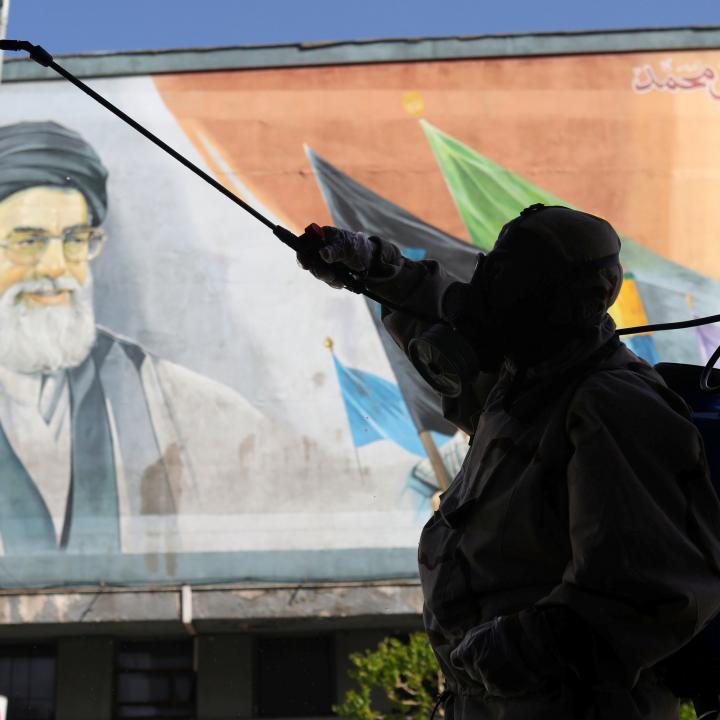
- Policy Analysis
- Policy Alert
By Mobilizing to Fight Coronavirus, the IRGC Is Marginalizing the Government

From establishing new provincial headquarters to deploying hundreds of thousands of troops and militia personnel on emergency duty, the Guards are seemingly using the crisis as an opportunity to expand their power at the local level.
After months of denying its domestic outbreak of coronavirus, Iran’s first major containment initiative was to establish a “national headquarters” for fighting the pandemic under President Hassan Rouhani’s direction, along with a council to back this new entity’s decisions. Yet the government’s incompetence, the gap between the president and his rivals, and the rapid spread of COVID-19 throughout the country soon convinced Supreme Leader Ali Khamenei to involve the armed forces.
Rather than placing troops under Rouhani’s control, however, Khamenei ordered the establishment of the Imam Reza Health and Medical Treatment Headquarters on March 12, headed by Armed Forces General Staff (AFGS) chairman Mohammad Bagheri. The general was asked to treat the situation as a biological defense drill, in line with Khamenei’s fantastical claim that the pandemic is part of an American biowarfare campaign against the regime.
By placing this new treatment headquarters under the AFGS—Iran’s highest military body—Khamenei essentially tasked all of the country’s armed forces with fighting the virus. For example, the Ministry of Defense and Armed Forces Logistics (MODAFL), which oversees all military-related planning and funding, was ordered to produce ventilators, protective equipment, and other medical supplies. The regular army (Artesh), which is normally responsible for protecting the country’s territorial integrity, was asked to decontaminate public places and set up temporary field hospitals and recovery beds. Similarly, the Law Enforcement Force (NAJA) has used some of its crowd control equipment to disinfect streets—albeit while displaying banners that indicated it was more focused on propaganda than public health.
Yet the most noteworthy moves have occurred within the Islamic Revolutionary Guard Corps and its Basij militia branches. Besides dispatching forces to screen patients, control the movement of people, disinfect public spaces, and manufacture protective equipment, the IRGC also activated a permanent “central biological defense headquarters” called Shafa (healing). This headquarters is not a new command; it was established in 2012 by the National Passive Defense Organization (NPDO). Subordinate to the AFGS, the NPDO was initially created in 2003 to enhance Iran’s battlefield survivability by strengthening infrastructure. Both the NPDO and Shafa ultimately report to the Khatam al-Anbia Central Headquarters (KACH), which is formally on the same level as the AFGS and is responsible for managing Iran’s armed forces during wartime.
In moving Shafa under its control, the IRGC established individual biological defense headquarters in each province of Iran. A decade ago, the IRGC was gradually decentralized into thirty-two Provincial Guards (one for each province except Tehran, which has two). This move was partly intended to ensure better coordination between Basij and IRGC forces operating in each province, and to better prepare the IRGC against any threats to the regime. The Provincial Guards now constitute a military administrative system that directly parallels the state administrative system, as embodied by provincial governments (ostandari) that fall under the control of the Interior Ministry and, ultimately, the president. Each Provincial Guard command oversees several local entities: an IRGC-Basij Region (Nahieh-e Basij-e Sepah) for each county (farmandari); at least one Basij district for each bakhsh (township), a smaller territorial unit consisting of a few towns (shahr) or rural districts (dehestan); and a Basij base for each neighborhood.
According to the NPDO’s bylaws, the provincial governor (ostandar) chairs all provincial passive defense headquarters, including Shafa. Yet moving Shafa under the IRGC’s authority has effectively put local Provincial Guard chiefs in charge instead.
By calling up some of its own forces and various Basij units—especially students, guild members, and medical practitioners—the IRGC has been able to mobilize around 600,000 personnel to help contain the virus nationwide. It has also organized eight committees in each provincial headquarters, with responsibility for the following tasks:
- Security and intelligence committees: Searching for warehouses of hoarded medical supplies, arresting people who criticize the regime’s response to the outbreak, and similar duties.
- Disinfection committees: Decontaminating public spaces.
- Education committees: Producing materials about the pandemic and how to contain it.
- Screening committees: Performing door-to-door virus checks.
- Logistical committees: Manufacturing basic equipment such as masks and hand sanitizer.
- Operational committees: Helping the regime control the movement of civilians and impose quarantines.
- Cultural committees: Performing duties such as sending people copies of Sahifeh Sajjadieh, a collection of prayers that Khamenei has recommended people read during the crisis.
- Public opinion management committees: Producing content (e.g., magazines and short videos) that promotes IRGC-Basij efforts to fight the virus.
Despite all these activities, many Iranians remain critical of the regime, including the IRGC. Social media comments, interviews with the author, and other observations indicate that the above campaigns are largely viewed as propaganda moves with few actual results.
At the same time, the creation of biological defense headquarters and the extended reach of the IRGC Provincial Guards are further alarming signs of the Rouhani government’s irrelevance and the growing securitization of the Islamic Republic. The power and social infiltration that the IRGC can attain through these provincial commands will only increase its weight in the eventual struggle to determine Khamenei’s successor. The most likely scenario at present is that the next Supreme Leader will be a puppet of the Guards; in fact, the military leadership may even dispense with the post entirely. Policymakers should therefore keep a close watch on further expansion among the Provincial Guards, with an eye toward the IRGC’s potentially paramount role in post-Khamenei Iran.
Saeid Golkar is an assistant professor in the Department of Political Science & Public Service at the University of Tennessee, Chattanooga, and author of the 2019 Washington Institute study “The Supreme Leader and the Guard: Civil-Military Relations and Regime Survival in Iran.”



